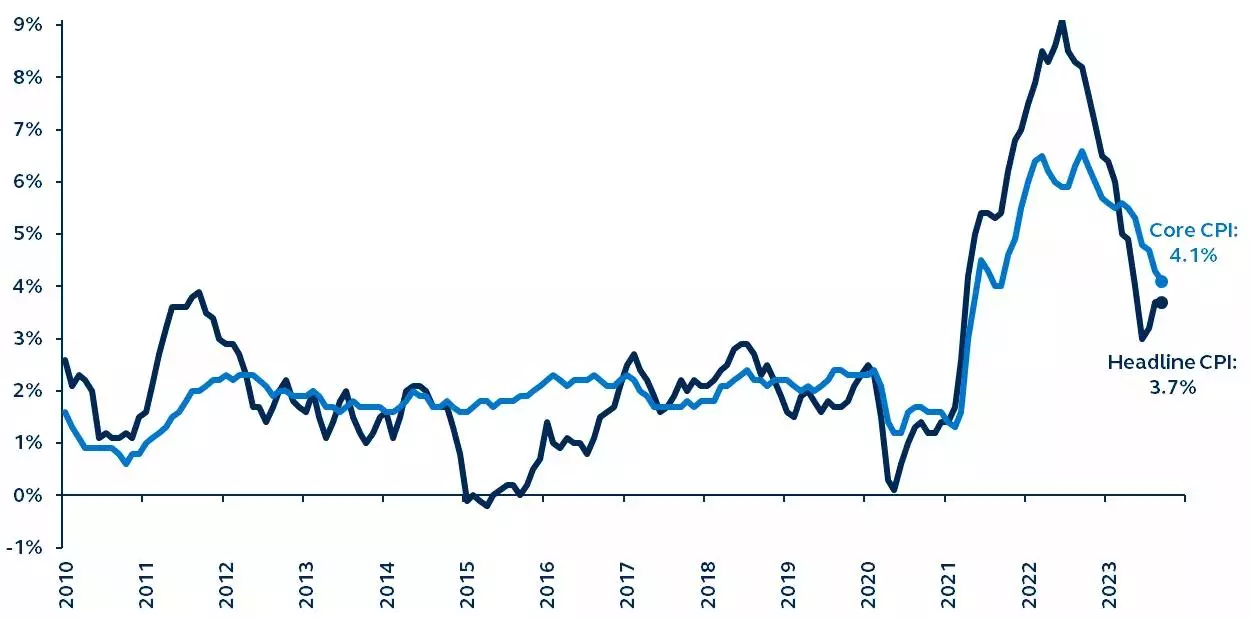By Seema Shah, Chief Global Strategist
The September Consumer Price Index (CPI) showed that inflation continues to edge towards the Federal Reserve’s (Fed’s) 2% target. Annual headline inflation remained unchanged at 3.7%, but core inflation eased from 4.3% to 4.1%, marking its lowest level since September 2021.
Despite the lack of surprises in the headline numbers of Friday’s inflation report, the continued strength of the important supercore inflation measure and the associated tightness of the labor market suggests that a potential resurgence of inflation cannot be ignored.
Consumer Price Index
Year-over-year % change, 2010–present

Source: Bureau of Labor Statistics, Principal Asset Management. Data as of October 12, 2023.
Report details:
- Headline inflation rose by 0.4% month-on-month in September. While that was lower than the 0.6% gain last month, it was slightly higher than consensus expectations. Gasoline was once again a major contributor to the headline inflation’s increase. By contrast, core inflation rose by 0.3% month-on-month in September, in line with expectations. While core inflation is moving in the right direction, it is worth noting that it would need to decelerate further to 0.2% month-on-month to be consistent with the Federal Reserve’s 2% inflation target.
- Breaking down core inflation reveals an ongoing disinflationary pattern within the core goods sector. While core goods inflation experienced a decrease of 0.4% and remained unchanged on an annual basis compared to a year ago, core services inflation showed a notable acceleration, rising from 0.3% month-on-month in August to 0.6% in September.
- Within core services, shelter inflation, which consists mainly of rents and owners’ equivalent rents, contributed to more than half of the gain in headline inflation in September, reaccelerating to 0.7% from 0.3% last month. Shelter inflation has been expected to decelerate as new lower rent leases replace old higher leases.
- The main concerns in the CPI report this month stemmed from “supercore” inflation, which measures core services inflation excluding shelter and is closely watched by Fed Chair Jerome Powell due to its link to the labor market. It extended its recent run of upside surprises, rising 0.6% in September – the largest monthly gain in a year. As long as supercore inflation remains elevated, the Fed will remain concerned and alert to renewed inflation pressures.
On the face of it, yesterday’s inflation report suggests that the Fed continues to make meaningful progress toward its inflation target. However, the supercore measure of inflation, reaching its highest point in a year, keeps the concerning narrative of “sticky inflation” very much in play. This suggests that the Federal Reserve will continue to carefully consider the possibility of another policy rate hike.
Recent Fed commentary has suggested that tightening financial conditions over the past few months reduces the need for additional tightening. Yet, as long as labor market data remains hot and until inflation shows a convincing and clear downward trend, the Fed will struggle to definitively call the peak for its tightening cycle.
Original Post
Editor’s Note: The summary bullets for this article were chosen by Seeking Alpha editors.
Read the full article here







